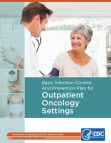 Basic Infection Control and Prevention Plan for Outpatient Oncology Settings
Basic Infection Control and Prevention Plan for Outpatient Oncology Settings
Download the complete Basic Infection Control and Prevention Plan for Outpatient Oncology Settings [PDF - 522 KB]
I. Fundamental Principles of Infection Prevention
Standard Precautions
Standard Precautions represent the minimum infection prevention measures that apply to all patient care, regardless of suspected or confirmed infection status of the patient, in any setting where healthcare is delivered. These evidence-based practices are designed to both protect healthcare personnel and prevent the spread of infections among patients. Standard Precautions replaces earlier guidance relating to Universal Precautions and Body Substance Isolation. Standard Precautions include: 1) hand hygiene, 2) use of personal protective equipment (e.g., gloves, gowns, facemasks), depending on the anticipated exposure, 3) respiratory hygiene and cough etiquette, 4) safe injection practices, and 5) safe handling of potentially contaminated equipment or surfaces in the patient environment.
Transmission-Based Precautions
Transmission-Based Precautions are intended to supplement Standard Precautions in patients with known or suspected colonization or infection of highly transmissible or epidemiologically important pathogens. These additional precautions are used when the route of transmission is not completely interrupted using Standard Precautions. The three categories of Transmission-Based Precautions include: 1) Contact Precautions, 2) Droplet Precautions, and 3) Airborne Precautions. For diseases that have multiple routes of transmission, a combination of Transmission-Based Precautions may be used. Whether used singly or in combination, they are always used in addition to Standard Precautions.
The risk of infection transmission and the ability to implement elements of Transmission-Based Precautions may differ between outpatient and inpatient settings (e.g., facility design characteristics). However, because patients with infections are routinely encountered in outpatient settings, ambulatory care facilities need to develop specific strategies to control the spread of transmissible diseases pertinent to their setting. This includes developing and implementing systems for early detection and management of potentially infectious patients at initial points of entry to the facility.
For detailed information on Standard and Transmission-Based Precautions, and summary guidance for outpatient settings, refer to the following documents:
- CDC Guide to Infection Prevention in Outpatient Settings
- CDC 2007 Guideline for Isolation Precautions
II. Education and Training
Ongoing education and training of facility staff are required to maintain competency and ensure that infection prevention policies and procedures are understood and followed. A list of names of designated personnel and their specific roles and tasks and contact information is provided in Appendix A.
1. Education and Training
- All facility staff, including contract personnel (e.g., environmental services workers from an outside agency) are educated and trained by designated personnel regarding:
- Proper selection and use of PPE
- Job- or task-specific infection prevention practices
- Personnel providing training have demonstrated and maintained competency related to the specific jobs or tasks for which they are providing instruction
- Training is provided at orientation, repeated at least annually and anytime polices or procedures are updated, and is documented as per facility policy
2. Competency Evaluations
- Competency of facility staff is documented initially and repeatedly, as appropriate for the specific job or task
- Regular audits of facility staff adherence to infection prevention practices (e.g., hand hygiene, environmental cleaning) are performed by designated personnel
III. Surveillance and Reporting
Routine performance of surveillance activities is important to case-finding, outbreak detection, and improvement of healthcare practices. This includes the surveillance of infections associated with the care provided by the facility (defined as healthcare-associated infections) and process measures related to infection prevention practices (e.g., hand hygiene).
1. HAI Surveillance
- Standard definitions are developed for specific HAIs under surveillance (e.g., central-line associated bloodstream infections)
- Designated personnel collect, manage, and analyze relevant data
- Surveillance reports are prepared and distributed periodically to appropriate personnel for any necessary follow-up actions (e.g., high incidence of certain HAIs may prompt auditing of specific procedures or a thorough infection control assessment)
2. Disease Reporting
- Facility staff adhere to local, state and federal requirements for reportable diseases and outbreak reporting [see Appendix B].
Contact Us:
- Centers for Disease Control and Prevention
1600 Clifton Rd
Atlanta, GA 30333 - 800-CDC-INFO
(800-232-4636)
TTY: (888) 232-6348 - New Hours of Operation
8am-8pm ET/Monday-Friday
Closed Holidays - cdcinfo@cdc.gov


